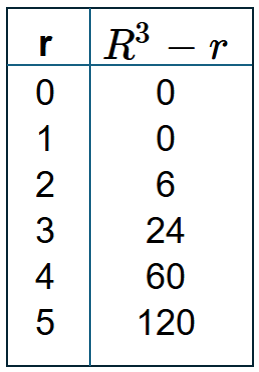Sign In | Starter Of The Day | Tablesmaster | Fun Maths | Maths Map | Topics | More
This is the Transum Newsletter for the month of November 2025. It's the month that hosts Fibonacci Day on 23 November. This date is chosen because, when written in the month/day format (11/23), the digits form the beginning of the famous Fibonacci sequence: 1, 1, 2, 3,...
While you contemplate that, here is the puzzle of the month:
Three friends, Attika, Burt and Celia, are having a rock, paper, scissors competition. They play two at a time with the third person spectating. The winner stays on, and the loser becomes the spectator. There are no draws. At the end of the day, they summarise the number of matches each had played:
Who lost the second match?

The solution and the clever way of working it out will be in next month's Newsletter. At that time I'll also reveal the inspiration for this puzzle, that I have customised slightly. In the meantime, please let me know if and how you solve it. You can reach me at: gro.musnarT@rettelsweN
While you think about that, here are some of the key resources added to the Transum website during the last month.
Meet Digimoji, a fresh twist on number puzzles where pupils build emoji equations and use the results to earn a trophy. They drag two emojis and an operation into place, then read the feedback to deduce which digit each emoji represents. Their attempts are logged automatically, and when they have enough clues they switch to a short quiz to lock in their final mapping. It is quick to learn, low-floor and high-ceiling, and perfect for developing reasoning, pattern spotting, and clear mathematical communication.
There is a limit on test calculations, and you could encourage pupils to justify each move they make. I would invite them to compare strategies after the reveal. The activity has multiple levels with smaller sets of digits for confidence-building, or larger sets for a tougher workout.
A bit of a niche application this, but here are some Flash Cards. They're only going to be of use to your students if they are studying the IB Mathematics Analysis and Approaches course. However, if you think they'd be useful for other courses, let me know. They help students ensure that they understand all the notation that is included in the syllabus.
My favourite Starter this month is Satisfaction which is assigned to 18 November and has 68 comments. It is a logic-based puzzle where students must place numbers 1 to 16 into a grid so that each row and column matches its heading (e.g., "even", "prime", "multiple of 5"). The twist is that the puzzle is deliberately impossible to complete, encouraging students to explore number properties and logical reasoning rather than aiming for a full solution.
Teachers report that students find the challenge engaging and thought-provoking, often managing to fit 11 to 13 numbers before hitting a wall. The activity promotes rich mathematical discussion and is ideal for group work, with the real goal being to prove why a perfect solution can't exist or to maximize the number of correct placements.
The book I'm reading this month is right at the top of the best-sellers lists. It's Dan Brown's Secret of Secrets. I'm three chapters in and already I'm thinking about people's ability to relate metric and imperial units "It was the largest castle complex in the world, stretching more than half a kilometer from its western gate to its eastern tip, and had a footprint of nearly five million square feet." It's amazing how, particularly in the UK, we're still juggling metric and imperial measures in everyday life.
Then, by coincidence, I heard the following story on a podcast:
"Air Canada Flight 143, a brand-new Boeing 767 with a known faulty fuel gauge, had to be fuelled by manual calculation at a time when Canada, and the airline, were mid-switch from imperial to metric units; most aircraft and paperwork still used pounds, the new jet used kilogrammes, and the conversion steps ran from a dipstick reading in centimetres to litres to mass in either kilogrammes or pounds using a conversion factor that, disastrously, was for pounds not kilogrammes, so the aircraft left with less than half of the intended 22,600 kilogrammes of fuel; compounding the problem, responsibility for the arithmetic was unclear because the 767 had no flight engineer, the pilot and co-pilot had not been trained for this task, one technician attempted the calculation and gave up, another nearly finished but ran out of space on his note and left it to the cockpit, making the metric-imperial confusion the root cause."
There then followed a twist or two, but to find out how that story ended you'll have to listen to the Cautionary Tales podcast, season 6, the 17 October episode.
So if you have students whose ambitions include being a fictional professor of symbology or a Canadian pilot, then a good place for them to start would be on Transum, where there are many activities helping students gain a better understanding of all sorts of different measures.
What seems like a long time ago now, subscriber Sharon asked for an exercise on domain and range. As a temporary measure a drag and drop activity was created but now I'm pleased to say that a full-blown exercise is ready and waiting. No surprise, the title is called Domain and Range.
There are four levels of multiple-choice questions progressing through varied notation systems. Level 4 challenges students to identify both domain and range for more complex functions involving logarithms, exponentials, and composite expressions. Each level contains ten multiple-choice questions with carefully chosen distractors that address common misconceptions. The activity includes a detailed notation guide with examples, making it ideal for both classroom use and independent practice as students develop confidence with this concept.
Don't forget you can listen to this month's podcast, which is the audio version of this Newsletter. Search for Transum Mathematics Puzzles.

Finally, the answer to last month's puzzle which was:
As I was going to Saint Bees
I passed a wood that had N trees
Each tree had N birds’ nests
And in each nest, N eggs rest
Now in this wood there lived a snake
And N eggs for breakfast it did take
Six children wished to save the rest
By guarding eggs in every nest
They divided the number of eggs remaining
By six (using their primary school training)
Can you calculate with exact precision
What’s the remainder of this division?
The remainder is zero as the number of eggs left is a multiple of 6. To see how that result is obtained, take a glance at the comments below
Sadly, I only received four correct answers for this puzzle. Hats off to Mala, Gill, Esther and Rick. The lack of quantity does not relate to a lack of quality. Quite the opposite!
That's all for now,
John
P.S. Why did all the metres run from the 1,000 m race?
They were scared of the killer metre at the end.
Do you have any comments? It is always useful to receive feedback on this newsletter and the resources on this website so that they can be made even more useful for those learning Mathematics anywhere in the world. Click here to enter your comments.
Did you know you can follow this newsletter on Substack completely free of charge? Please note this is separate from a paid subscription to the Transum website, which unlocks a much wider range of premium resources.
Gill, Leighton Buzzard
Monday, October 6, 2025
"Firstly - I love Transum- keeping students engaged with all your hard work makes my life so much more pleasant in the classroom.
This puzzle was a little tricky for my Year 7s - although they made some interesting expressions and connections with the \(N\)s!!
However some smarter ones in Y8 (we are a middle school so only go up to Y8, although we teach Y9/Y10 content to our more able) at our drop in maths clinic (yes it's a thing, and yes it's well turned out) came up with this:
If there are \(N\) trees, \(N\) nests and \(N\) eggs then the total number of eggs is \(N \times N \times N \equiv N^3 \). The snake eats \(N\) eggs so there are \(N^3 - N\) eggs left.
(after a lot of experimentation and a couple of suggestions) - they factorised to get
\(N(N^2-1) \equiv N(N-1) (N+1)\) ; figuring that \(N-1, N \text{ and } N+1\) must be consecutive numbers, (at least) one must be even (divisible by 2) and another must be a multiple of 3 (divisible by 3) which means that they must be divisible by 6 - hence there cannot be any remainder and the children can guard the eggs evenly.
I was quite impressed with the collaboration / wider thinking even when they went off down a rabbit (snake) hole! Keep them coming! "
Rick, USA
Friday, October 10, 2025
"I really enjoyed this puzzle. Here is the full answer to the October puzzle of the month:

Since there are N trees, N nests in each tree, and N eggs in each nest, we start with \(N^3\) eggs. From this, we need to subtract N eggs, since that is how many were eaten by the snake. Therefore:
$$\text{Eggs} = N^3 - N$$ N can also be represented as (x+r), where x is the value of the integer division of N by the number of children and r is the remainder. Therefore: $$\text{Eggs} = (x+r)^3 - (x+r) \text{ or}$$ $$\text{Eggs} = x^3 + 3x^2r + 3xr^2 + r^3 - x - r$$ Since we are only concerned with the remainder of the division of eggs by the number of children, we can eliminate any term with x, since x is evenly divisible by the number of children, leaving: $$\text{Eggs remainder} = r^3 - r$$ There are only six children, so let's check what the remainder would be for the six values of r (0 to 5). See the following table:
We can see that the values in the second column of the table are all evenly divisible by six, so the remainder, regardless of the value of \(N\), will always be zero. Hence, the remaining eggs can be evenly distributed among the six children, with no extra eggs. "
Rick, USA
Saturday, October 11, 2025
"Based on your response, I assumed there are other ways to solve this puzzle. So, during lunch, I thought of another solution.
Eggs \(= N^3 – N\)
Eggs = \(N(N^2 - 1)\)
Eggs = \(N(N + 1)(N - 1)\)
We see that Eggs is the product of three consecutive integers. Hence, one of these integers must be evenly divisible by 3 and another or the same must be evenly divisible by 2. Therefore, Eggs is evenly divisible by six, leaving no remainder.
There is the degenerate case where \(N = 1\). However, one can consider zero divided by three has no remainder, or that one tree does not a forest make.
Regards, Rick."